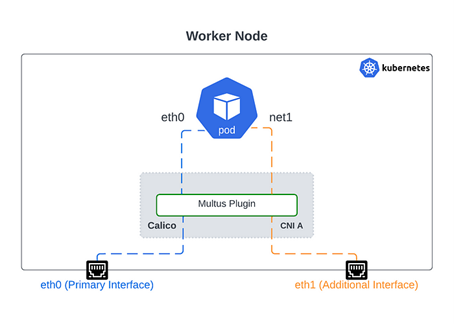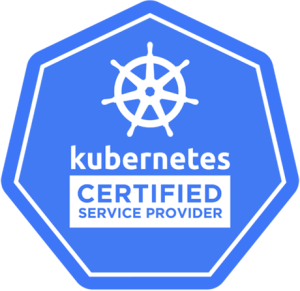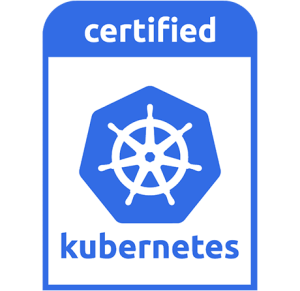Blogs
As Kubernetes continues to dominate the world of container orchestration, the need for more flexible and advanced networking solutions within this environment is growing. Enter Multus, an open-source Container Network Interface (CNI) plugin that enables the attachment of multiple network interfaces to Pods within a Kubernetes cluster.
In this blog post, we will delve into the world of Multus, discussing its functions, benefits, and why it might be the networking solution you’ve been looking for.
Understanding Multus
Multus CNI serves as a “meta-plugin”, a plugin that can call multiple other CNI plugins. It enables the Kubernetes pods to have more than one network interface, allowing for enhanced and customized networking features. It essentially extends the Kubernetes networking capabilities to support multiple interfaces in Pods, making it possible to implement various network configurations, each providing specific network services.
In essence, Multus works as a coordinator between container runtimes and plugins. While it does not handle the network configuration itself, it can leverage other plugins to do so. Multus supports a wide array of these plugins, from reference plugins like Calico that implement CNI specifications to third-party plugins like Weave, Flannel, Contiv, and Cilium.
In addition to this, Multus can also attach Data Plane Development Kit (DPDK) and Single Root Input/Output Virtualization (SRIOV) interfaces to pods, which can greatly enhance the network performance for network-intensive workloads.

How Multus Works
The operation of Multus is grounded in its ability to serve as an arbiter for other CNI plugins. It invokes plugins like Flannel, Calico, vHost CNI, or SR-IOV to create network interfaces.
This functionality is enabled by the Kubernetes component Kubelet, which runs on each node in the Kubernetes cluster. Kubelet manages the lifecycle of pods running on its node, and establishes network interfaces for each of these pods. It uses a Multus CNI configuration file to set up each pod’s network. In this scenario, Kubelet is configured to use the Container Network Interface as its networking plugin. When invoked to set up a pod, Kubelet calls its container runtime and provides it with a network plugin wrapper — Multus.
Practical Implementation: Attaching Flannel Network to a Calico-Based Pod
Assume that you’ve already set up your Kubernetes cluster with Calico as the default CNI plugin. To introduce Multus into this setup, the first step involves creating a NetworkAttachmentDefinition for the additional network. This serves as an indication to Multus about the details of the new network and the underlying CNI it should call upon.
For instance, if you wish to add a Flannel network, the existing Flannel CNI configuration (usually found in the /etc/cni/net.d/ directory) can be converted into a NetworkAttachmentDefinition. The key point here is to ensure that the spec.config field in the NetworkAttachmentDefinition matches the contents of the Flannel configuration file. Once this is done, the Pods can be configured to use this additional network.
Here’s an example of how you might create a NetworkAttachmentDefinition for Flannel:
cat <<EOF | kubectl create -f -
apiVersion: "k8s.cni.cncf.io/v1"
kind: NetworkAttachmentDefinition
metadata:
name: flannel-net
spec:
config: '{
"name": "cbr0",
"type": "flannel",
"delegate": {
"isDefaultGateway": true
}
}'
EOF
After creating the NetworkAttachmentDefinition, you can instruct a Pod to use the Flannel network by adding the network name to the
k8s.v1.cni.cncf.io/networks annotation in the Pod definition, like this:
apiVersion: v1
kind: Pod
metadata:
name: sample-pod
annotations:
k8s.v1.cni.cncf.io/networks: flannel-net
spec:
containers:
- name: sample-container
image: nginx
With this setup, the Pod will have interfaces on both the Calico network (as the default network) and the Flannel network (as the additional network). This truly demonstrates the power of Multus in offering flexible, multi-network solutions for Kubernetes Pods.
Remember, you can repeat these steps for each additional network that you’d like to add, creating a new NetworkAttachmentDefinition for each. By utilizing Multus, your Pods can simultaneously exist on different networks, thereby broadening the horizons for complex networking scenarios and multi-tenant setups.
Functions of Multus
- Multi-Network Support
Multus allows Pods to have more than one network interface. Each interface can connect to a different network, and each network can be controlled by a different CNI plugin. This means that different networks can have different features depending on the CNI plugin used.
- Compatibility
Multus is compatible with all the CNI plugins that follow the CNI specification. This allows for extensive customization and control over network configurations, as you can choose different plugins to provide specific networking features.
- Flexibility
Because Multus allows each pod to connect to multiple networks, it offers significant flexibility. This can be particularly beneficial in cases where you need to segregate network traffic or provide direct connectivity to external networks or hardware.
Advantages of Multus
- Enhanced Network Customization
Multus allows for a high degree of network customization. By enabling each pod to connect to multiple networks, it becomes possible to design sophisticated network architectures that meet specific requirements, such as segregating sensitive traffic, connecting directly to external networks, or using hardware devices directly.
- Broad Compatibility
Multus’ compatibility with all CNI plugins that follow the CNI specification means you can use it with a wide variety of existing networking solutions. This broad compatibility allows you to leverage the capabilities and features of multiple networking solutions within your Kubernetes environment.
- Advanced Networking Use Cases
Multus is particularly beneficial for advanced networking use cases. For instance, in network function virtualization (NFV) use cases, it allows the network functions to be connected to multiple networks as needed, thus meeting the diverse networking requirements of these applications.
How Multus Simplifies Network Migrations and Enables Multiple Networks in a Cluster
Multus plays a significant role in simplifying network migrations and facilitating multiple separate networks within a cluster. It allows different applications running on the same cluster to use different network solutions. This means that if you need to move from one networking solution to another, you can do so on a per-application basis rather than having to migrate the entire cluster at once. This approach allows for a smoother transition with minimized downtime.
In terms of supporting multiple networks, Multus’s ability to create multiple network interfaces for each pod allows for a high degree of network segmentation within the cluster. This can be particularly useful for isolating network traffic for specific applications or for implementing fine-grained network policies.
By delivering such advanced capabilities, Multus is undoubtedly an invaluable tool that makes network migrations easier and enables the existence of several separate networks within a cluster, thus significantly expanding the networking capabilities of Kubernetes.
Conclusion
As businesses increasingly turn to Kubernetes for their container orchestration needs, the need for more advanced networking solutions within Kubernetes continues to grow. Multus provides an open-source solution that extends the networking capabilities of Kubernetes, allowing for the creation of Pods with multiple network interfaces.
Its flexibility, compatibility, and multi-network support make it a valuable tool for businesses looking to enhance their Kubernetes networking. Whether you’re looking to segregate network traffic, provide direct connectivity to external networks, or just increase your network customization options, Multus might just be the tool you need.
Remember, there is no one-size-fits-all solution in the world of Kubernetes networking. It’s all about finding the right tools that fit your specific needs and requirements. And for many, Multus might be the perfect fit.
Check out our latest blogpost
Kubernetes in Focus: An Outlook on Future Growth Areas
Any Questions?
Please feel free to contact us for any question that is not answered yet.
We are looking forward to get in contact with you!
KubeOps GmbH
Hinter Stöck 17
72406 Bisingen
Germany
-
Telefon:
+49 7433 93724 90
-
Mail:
This email address is being protected from spambots. You need JavaScript enabled to view it.





